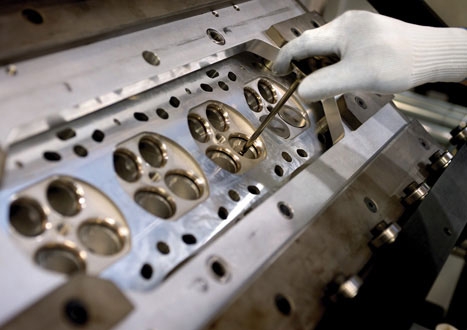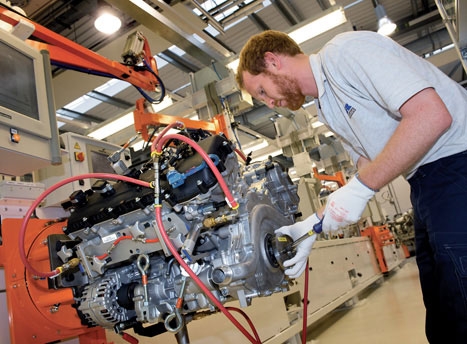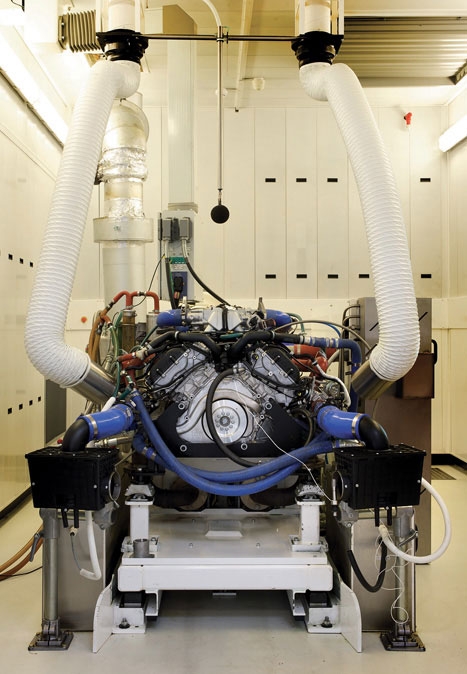The nervous wrist-ward glances, muttered last-minute instructions, obsessive tidying and palpable tension said it all: Ron Dennis was coming to visit. And the engineers in charge of building the engine for Britain’s latest supercar were anxiously hoping that their new facility would be up to the McLaren chief’s legendarily exacting standards.

He was also particularly pleased with his team’s work on improving the sealing integrity of the engine by eliminating the T-joints typically used to join the cylinder heads to the engine block. To test this, and to make sure that the engine wouldn’t leak, Yates’s team put it through an exceptionally tough thermal shock test. The engine was started at an ambient temperature, put up to full power almost immediately, left running at around 115°C and then crashed back to 20°C. Repeated over and over again, this test gives the structure of the engine an extremely hard time, explained Yates. ’It expands internally faster than it does externally. All of the sealing joints and interfaces within the engine and the moving parts have got to survive that very arduous test.’
Indeed, testing was a key element throughout development, whether it was the use of Ricardo’s own software to simulate and model engine performance and valvetrain dynamics or the use of dynamometers to test as many parts as possible. ’We had seven beds in parallel running the engine and have completed 5,000 hours of testing,’ said Yates.
Meeting the design challenges of the brief was one thing, but the Ricardo team also had to simultaneously design and develop a manufacturing process, and this meant that, from the start, the design team had to work closely with the manufacturing team. ’Ideas from both parties had to be evaluated and traded,’ said Yates. ’We took compromise in manufacturing where necessary and compromise in design in other areas. For example, the assembly of the front-end drive was a bit tougher for the manufacturing team than we’d like but from the design point of view provides good sealing technology.

’Design for assembly was an ever-present concern,’ he added. ’Rapid-prototype models of the engine were used by the manufacturing team to confirm that they could get the assembly process right.’
To make sure that the engine wouldn’t leak, Yates’s team put it through a very tough thermal shock test
Ricardo production manager Tom Soar was the engineer responsible for getting the assembly facility up and running. ’Our brief was to build and set up a complete manufacturing facility in 18 months from scratch,’ he said. ’That was to build the building, design and put in equipment, hire all the people and set up all the processes - both the manufacturing processes and the supporting processes necessary to build the engine.
'Everybody on the project has learned a tremendous amount about setting up a factory,’ added Soar. 'I think from Ricardo’s point of view, it’s something we’d never done before, and starting from scratch does have some advantages because you’re able to build the processes and get the equipment in, in the way that it should be done.’

The production strategy hinges upon a few key pieces of equipment spread across 13 stations: a cylinder head sub-assembly line, a main assembly line, a hot test cell and pre-delivery inspection stations. Each of these stations takes 45 minutes to complete its task. 'McLaren will build a car every 45 minutes, so we will build an engine every 45 minutes,’ said Soar.
He added that he believes the facility is a great advertisement for the UK’s manufacturing prowess.
’Our vision for the whole project was to create a world-class lean manufacturing facility - from the outset, we wanted to include as many lean manufacturing principles as possible and make it really world class and prove that we can do it in the UK. The whole of our assembly facility is designed to build in quality, making sure we have no non-quality moving through to each station.
’We have a no-faults forward philosophy - single-piece flow, one engine at one station at any one time. That means if we ever find a problem, we’ve only got to check that one engine. At each station, we have a lot of error proofing to detect if a fault has been made and to alert a team member before it moves into the next station and becomes more difficult to correct.’
Obviously delighted with what his team has achieved, Soar said that the resulting 600m² facility will produce almost 2,000 engines over the next 12 months and could be scaled up to produce double that volume.
With almost 1,900 orders for the £168,000 car already taken and deliveries beginning last month, Ricardo’s facility will certainly be working near its intended capacity for the first year. Beyond that, only time will tell, but Soar is confident the operation would have no trouble coping with more. ’It’s only sensible to make provision for what would happen if we had to build 50 extra engines a week - which is why we’ve built in all that future proofing.’
As Ron Dennis cast his eye over the new facility, nervous laugher greeted his typically deadpan warning to the assembled engineers. ’Please put them together carefully,’ he said. ’I don’t want any of them coming back to me.’
Given the thought, time and focus on quality that has dominated the project, Ricardo’s engineers can be pretty confident they won’t be incurring the wrath of McLaren’s boss any time soon.
Targets for the M838T engine
- Engineers were tasked with meeting a set of strict specifications Power: 600PS at 7,500rev/min
- Torque: 600Nm at 3,000rev/min
- Mass: less than 200kg
- CO2: less than 300g/km
- Transient response: 0.5 seconds to 75 per cent desired boost
- Maximum speed: 8,500rev/min
- Idle speed: 850rev/min
- Emissions: Eu 5/ULEV2
Good vibrations
Ricardo’s team of engineers worked to ensure that the engine sound was as impressive as possible
Speed and acceleration may be critical, but an equally important aspect of supercar performance is a more subjective quality: the sound it makes. And throughout the design process, Ricardo’s team was mindful of the importance of ensuring the engine sound was as spectacular as possible. ’Sound quality is one of the most important attributes to help deliver a feeling of excitement to the customers,’ said Ricardo’s noise and vibration specialist Matt Maunder. ’It’s important both inside the car and outside for any potential customers.’
He explained that this is effectively a process of engineering out undesirable engine noises such as squeaks, rattles and ticks, while promoting the characteristics that people enjoy such as the exhaust note, the intake note and other audible cues that enhance a driver’s sense that he or she is exercising the engine’s capacity and capability.
On the mule vehicle supplied by McLaren, the major source of rattling was the engine’s gear-driven ancillary system, so Maunder’s team installed a chain system for the ancillaries.
He then turned his attention to the exhaust. ’The mule vehicle didn’t have much character to it, so one of the first things we did was install a new exhaust system,’ said Maunder. ’This was designed using our Wave software so that we knew it would generate a much better sound. Then we built a handmade prototype - that basic concept system was then productionised.
To optimise the interior sound, his team turned to the intake system. ’We started off with a mixture of many uncontrolled noise sources, so we added a sound generator system that takes pressure pulsation from the intake manifold and delivers them into the interior of the car. By controlling the way the sound is transferred, we have good control over the sound inside the vehicle and that was carried through to the production vehicle.’





Red Bull makes hydrogen fuel cell play with AVL
Surely EVs are the best solution for motor sports and for weight / performance dispense with the battery altogether by introducing paired conductors...